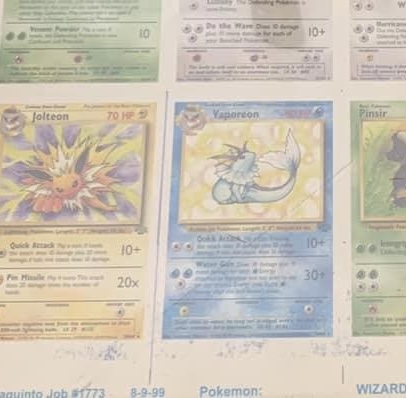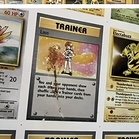As far as I am aware, disco holos are similar to all of these Jungle cards in that they were cut from a sheet (unless there exist stand-alone cards that I’m not aware of). I think what was being tested is a little more obvious though. I’d be kind of surprised to see PSA authenticating those unless it was just categorized as a “cut” like the sports cards shown earlier in this thread.
Forgive me for being late to the NFC/Professional grading debate, but I think both @churlocker and @pfm’s takes are reasonable and together are an excellent example of why the concept of “authentic” is full of grey areas that we often don’t recognize. When I ran this poll in November, there was a lot of interesting stuff to come out of it. Out of approximately 70 votes, E4 members rated test cards that were made with authentic materials but never intended to be distributed to the public at 8.6/10 for authenticity. However, the rating for cards manufactured with authentic materials but with questionable or unverifiable provenance at 5.6/10. I’d hazard a guess that test sheets that end up being NFC’d into cards would probably be somewhere in the middle, but it would be interesting to see exactly where.
CGC in particular has been much more adventurous with their grading, where their concept of authenticity in most cases is as long as it was printed with authentic materials, it’s good to go. CGC doesn’t care where or how you get the card or how it gets to be shaped like a card. PSA has been more strict, considering method of distribution and provenance as part of authenticity as well. It’s strange to see PSA grading a test print given how they’ve assessed authenticity in the past, but nevertheless they’ve done it.
I think it’s healthy to have different concepts of authenticity present within the grading marketplace, as long as those concepts are clear and consistent, which in many cases they are not. CGC will grade Prerelease Raichu but won’t grade Collector Charizard. PSA will grade this test print Pidgeot but won’t grade an Art Academy Mew. These standards of authenticity also aren’t published anywhere, which makes it hard as consumers to understand exactly what grading companies are attesting to when they claim a card is authentic.
It reminds me of this discussion about altered signature cards. Most grading companies only attest to the authenticity of the signature itself, but many signatures these days have personalizations and sketches. Is a signature still “authentic” if the personalization has been wiped and a sketch is added to the card afterwards by someone who isn’t the artist? What if someone colors in their Charizard after the artist signed the card to make it shiny?
Whether it’s NFC’d test prints or altered signatures, part of the “ick” we feel when we see them encapsulated is because CGC’s broader concept of authenticity is very new to the market–and auto fever is testing signature authentication to never-before-seen levels. I don’t think people are used to seeing a card in a graded slab and then hearing that someone broke down a test sheet so they could make more profit off of selling cards individually. It doesn’t feel right because we’re used to having a more restrictive approach to these things. While I personally agree with the idea that labeling cards as NFC is the best way to go about this, I also see the point that it is hard to objectively determine where and how a cut was made, in the same sense that it’s hard to determine exactly who colored in a Charizard or sketched a Pokemon on a signed card.
The point of my post is that you’re never going to arrive on a perfect definition of authentic. But grading companies need to publish and make very obvious what their standards for authenticity are, and then apply them consistently throughout.
@fourthstartcg Great post! I just wanted to add that why PSA doesn’t grade the Mew AA card is because the winner threatened to sue PSA for grading the extra copies. This is also a major factor on why they paused AA for awhile. Not defending PSA’s decision, and certainly not the asshole mew winner, but just sharing that info as it was the primary factor for why they stopped grading AA cards.
Certainly none of us could say for sure, we are not lawyers with law degrees from TCG College of Law, but is there even a reasonable legal basis to that threat? I have a hard time seeing what sort of claim the artist has in that situation. ![]()
I can’t even guess what the legal claim could feasibly be.
100%! I am not a lawyer but common sense would tell me that the pokemon company owns the rights to pokemon, not some random winner of a contest.
I dont think they have any. Im like 99% sure that when you enter those illustration contests you give up ownership of your submission otherwise pokemon couldnt turn it into a card without your approval of said contest.
Thanks for posting the article! It’s a cute little story but not at all what I was hoping for.
My gut feeling is these are not test prints of any kind, I’m beginning to suspect these are error sheets and were thrown off the line prior to the yellow border being laid down. Likely due to these ink blots. Just a hunch, still really cool and the white borders are sick but not as “premium” as a test print/proof would be.
Below is the sheet that these jungle cards are cut from. Interestingly, the white border sheet that TCA gaming owns also has an ink stain. ![]()

Edit:
Even these white border base set sheets have some junk on them. Does anyone know if WOTC used to QC the sheets prior to the yellow border being laid? If so that could explain a lot.

My initial feeling is that the spot colour (red on HP, black for text, yellow on border) was laid down all on one go through the printer (each one being a separate roller). But a bit of research suggests that probably isn’t the case and the sheets might have to go through the printer multiple times to lay down the spot colours.
So your theory could be 100% right, that a select number of sheets just didn’t get all the layers applied for any number of unknown reasons. More reason to question the “test print” designation.
I’m thinking it would be better to just group all these items as “Unreleased” on the labels rather than attribute them to tests, misprints, etc. Seems like a suitable catch-all.
Ooooo I like that. I vote for this.
“Unreleased NFC white border” would work for me. ![]()
I think this is the most honest and objective description while also retaining a lot of the “mysterious appeal” that makes people like these cards in the first place.
Hire this person
I wonder why the Pokemon Company doesn’t explain such cases?
Because they don’t know. This happened 25 years ago. I would bet that everyone (or nearly everyone) who worked at WoTC in the late 1990s is not working for TPCi in 2024.
The only person that could potentially give some insight would be @wasmer since he’s the guy that bought the sheets. Assuming of course the person he bought them from gave him an origin story of some kind. Even then I’d be highly skeptical 🕵🏻♂️
It was just a job for most people that worked at wotc. We collectors project the meaning and value for stuff that was most likely unintentional.
I mean yeah, that much is implicit. Doesn’t mean there isn’t a story to be told. Heck, it could be as simple as “Yeah, I saved these from the trash because I was gonna take them to my kids.” At least that would be SOMETHING ![]()
For sure! That is what I mean, it could just be, “I dunno” for why they exist, rather than some purposeful test run.
Ah. I gotcha.
I mean why do any of us exist? Ya know? Where is that philosophy guy? Bring him back. ![]()

